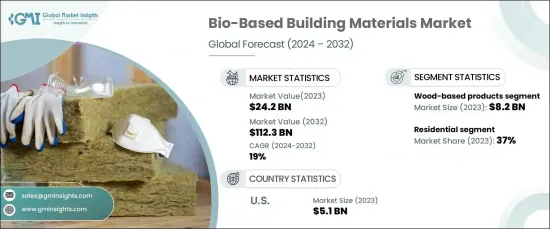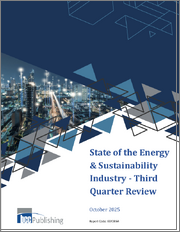
|
시장보고서
상품코드
1664904
바이오 건축자재 시장 기회, 성장 촉진 요인, 산업 동향 분석, 예측(2024-2032년)Bio-Based Building Materials Market Opportunity, Growth Drivers, Industry Trend Analysis, and Forecast 2024 - 2032 |
||||||
바이오 건축자재 세계 시장은 2023년에 242억 달러에 달했으며, 2024년부터 2032년에 걸쳐 19%의 놀라운 연평균 복합 성장률(CAGR)로 성장할 것으로 예상됩니다.
이 성장의 배경은 지속가능성에 대한 노력 증가와 환경 친화적인 건축자재에 대한 수요 증가입니다. 바이오 재료는 재생 가능한 특성, 낮은 탄소 발자국 및 실내 공기의 질을 향상시키는 능력으로 높은 인기를 얻고 있으며 현대의 지속 가능한 건축 기술의 핵심입니다.

제품 유형별로 볼 때 시장은 천연섬유, 목재 제품, 농업 폐기물 제품, 바이오 폴리머, 바이오 단열재, 바이오 콘크리트 등으로 구분됩니다. 이 중 목재 제품은 2023년의 평가액이 82억 달러로 시장을 선도했으며, 2024년부터 2032년까지의 CAGR은 19.5%로 성장할 것으로 예상되고 있습니다. 목재의 지속가능성, 재생가능성 및 생분해성으로 인해 목재는 기존의 재료보다 뛰어난 선택이 되었습니다. 범용성, 강도 및 환경에 미치는 영향을 줄임으로써 목재는 건설 및 인프라 프로젝트의 구조적 용도와 미관적 용도 모두에서 유력한 선택이되었습니다.
| 시장 범위 | |
|---|---|
| 시작연도 | 2023년 |
| 예측연도 | 2024년-2032년 |
| 시작금액 | 242억 달러 |
| 예측 금액 | 1,123억 달러 |
| CAGR | 19% |
시장은 최종 용도에 따라 주택, 상업, 산업 및 인프라의 각 분야로 분류됩니다. 2023년은 주택분야가 압도적이었으며 시장 점유율의 37%를 차지했고, 2032년까지의 CAGR은 19.3%의 성장률을 기록할 것으로 예상됩니다. 주택 소유자는 실내 공기의 질을 개선하고 환경에 미치는 영향을 최소화하는 재료를 선호합니다. 유해한 화학물질과 배출물이 없는 바이오 대체 재료는 지속가능하고 건강한 거주 공간에 대한 수요가 증가함에 따라 주택 분야에서의 채용을 촉진하고 있습니다.
미국의 바이오 건축자재 시장은 2023년에 51억달러의 매출을 올렸으며, 2024년부터 2032년까지 연평균 복합 성장률(CAGR) 19.2%의 성장률로 성장할 예정입니다. 미국의 성장은 주로 녹색 건축 실천을 촉진하는 정부 우대 조치, 세제 우대 조치 및 인증 프로그램에 의해 초래됩니다. 지속 가능한 인프라와 에너지 효율적인 건물에 초점을 맞춘 정책은 바이오 재료의 채택을 더욱 가속화하고 미국을 이 시장의 세계 리더로 확고히 하고 있습니다.
목차
제1장 조사 방법과 조사 범위
- 시장 범위와 정의
- 기본 추정과 계산
- 예측 계산
- 데이터 소스
- 1차
- 2차
- 유료 정보원
- 공적 정보원
제2장 주요 요약
제3장 업계 인사이트
- 업계 생태계 분석
- 밸류체인에 영향을 주는 요인
- 이익률 분석
- 변혁
- 장래의 전망
- 제조업체
- 유통업체
- 공급자의 상황
- 이익률 분석
- 주요 뉴스와 대처
- 규제 상황
- 영향요인
- 성장 촉진요인
- 지속 가능한 건설에 대한 수요 증가
- 기술의 진보
- 업계의 잠재적 리스크 및 과제
- 초기 비용 상승
- 성장 촉진요인
- 성장 가능성 분석
- Porter's Five Forces 분석
- PESTEL 분석
제4장 경쟁 구도
- 소개
- 기업의 시장 점유율 분석
- 경쟁 포지셔닝 매트릭스
- 전략 전망 매트릭스
제5장 시장 추정 및 예측 : 재료 유형별, 2021년-2032년
- 주요 동향
- 천연섬유
- 목재 베이스 제품
- 농업 폐기물 기반 제품
- 바이오폴리머
- 바이오 단열재
- 바이오 콘크리트
- 기타(바이오 접착제 및 바인더 등)
제6장 시장 추정 및 예측 : 건설 유형별, 2021년-2032년
- 주요 동향
- 신축
- 개수 및 개축
제7장 시장 추정 및 예측 : 용도별, 2021년-2032년
- 주요 동향
- 구조 부재
- 단열재
- 바닥재
- 벽 패널 및 클래딩
- 지붕재
- 기타(장식재 등)
제8장 시장 추정 및 예측 : 최종 용도별, 2021년-2032년
- 주요 동향
- 주택용
- 상업용
- 산업용
- 인프라
제9장 시장 추정 및 예측 : 유통 채널별, 2021년-2032년
- 주요 동향
- 직접
- 간접
제10장 시장 추정 및 예측 : 지역별, 2021년-2032년
- 주요 동향
- 북미
- 미국
- 캐나다
- 유럽
- 영국
- 독일
- 프랑스
- 이탈리아
- 스페인
- 러시아
- 아시아태평양
- 중국
- 인도
- 일본
- 한국
- 호주
- 라틴아메리카
- 브라질
- 멕시코
- 중동 및 아프리카
- UAE
- 사우디아라비아
- 남아프리카
제11장 기업 프로파일
- BASF SE
- Clayworks Ltd.
- Cork House
- Durisol
- EcoCocon
- ECOR Global
- Forbo Flooring Systems
- Green Building Supply
- Hempitecture Inc.
- Interface, Inc.
- Kirei
- MycoWorks
- NatureWorks LLC
- Novamont SpA
- Plantd
The Global Bio-Based Building Materials Market reached USD 24.2 billion in 2023 and is projected to grow at an impressive CAGR of 19% from 2024 to 2032. This growth is fueled by increasing sustainability initiatives and the rising demand for eco-friendly construction materials. Bio-based materials have become highly sought after due to their renewable nature, low carbon footprint, and ability to enhance indoor air quality, making them a cornerstone of modern, sustainable building practices.

By material type, the market is segmented into natural fibers, wood-based products, agro-waste-based products, bio-polymers, bio-insulation materials, bio-concrete, and others. Among these, wood-based products led the market with a valuation of USD 8.2 billion in 2023, and they are expected to grow at a CAGR of 19.5% from 2024 to 2032. Wood's sustainability, renewability, and biodegradability make it a standout choice over traditional materials. Its versatility, strength, and reduced environmental impact position it as a go-to option for both structural and aesthetic applications in construction and infrastructure projects.
| Market Scope | |
|---|---|
| Start Year | 2023 |
| Forecast Year | 2024-2032 |
| Start Value | $24.2 Billion |
| Forecast Value | $112.3 Billion |
| CAGR | 19% |
The market is categorized into residential, commercial, industrial, and infrastructure sectors based on end-use. The residential segment dominated in 2023, capturing 37% of the market share, and is projected to grow at a CAGR of 19.3% through 2032. Homeowners are increasingly prioritizing materials that improve indoor air quality and minimize environmental impact. Bio-based alternatives, free from harmful chemicals and emissions, align with the growing demand for sustainable, healthier living spaces, driving their adoption in the residential sector.
The U.S. bio-based building materials market generated USD 5.1 billion in 2023 and is set to expand at a CAGR of 19.2% from 2024 to 2032. Growth in the U.S. is primarily driven by government incentives, tax benefits, and certification programs promoting green construction practices. Policies focused on sustainable infrastructure and energy-efficient buildings have further accelerated the adoption of bio-based materials, solidifying the U.S. as a global leader in this market.
Table of Contents
Chapter 1 Methodology & Scope
- 1.1 Market scope & definitions
- 1.2 Base estimates & calculations
- 1.3 Forecast calculations
- 1.4 Data sources
- 1.4.1 Primary
- 1.4.2 Secondary
- 1.4.2.1 Paid sources
- 1.4.2.2 Public sources
Chapter 2 Executive Summary
- 2.1 Industry synopsis, 2021-2032
Chapter 3 Industry Insights
- 3.1 Industry ecosystem analysis
- 3.1.1 Factor affecting the value chain
- 3.1.2 Profit margin analysis
- 3.1.3 Disruptions
- 3.1.4 Future outlook
- 3.1.5 Manufacturers
- 3.1.6 Distributors
- 3.2 Supplier landscape
- 3.3 Profit margin analysis
- 3.4 Key news & initiatives
- 3.5 Regulatory landscape
- 3.6 Impact forces
- 3.6.1 Growth drivers
- 3.6.1.1 Increasing demand for sustainable construction
- 3.6.1.2 Technological advancements
- 3.6.2 Industry pitfalls & challenges
- 3.6.2.1 Higher initial costs
- 3.6.1 Growth drivers
- 3.7 Growth potential analysis
- 3.8 Porter’s analysis
- 3.9 PESTEL analysis
Chapter 4 Competitive Landscape, 2023
- 4.1 Introduction
- 4.2 Company market share analysis
- 4.3 Competitive positioning matrix
- 4.4 Strategic outlook matrix
Chapter 5 Market Estimates & Forecast, By Material Type, 2021-2032 (USD Billion)
- 5.1 Key trends
- 5.2 Natural fibers
- 5.3 Wood-based products
- 5.4 Agro-waste-based products
- 5.5 Bio-polymers
- 5.6 Bio-insulation materials
- 5.7 Bio-concrete
- 5.8 Others (bio-adhesives and binders, Etc)
Chapter 6 Market Estimates & Forecast, By Construction Type, 2021-2032 (USD Billion)
- 6.1 Key trends
- 6.2 New construction
- 6.3 Renovation and retrofit
Chapter 7 Market Estimates & Forecast, By Application, 2021-2032 (USD Billion)
- 7.1 Key trends
- 7.2 Structural components
- 7.3 Insulation
- 7.4 Flooring
- 7.5 Wall panels and cladding
- 7.6 Roofing
- 7.7 Others (decorative materials, Etc)
Chapter 8 Market Estimates & Forecast, By End Use, 2021-2032 (USD Billion)
- 8.1 Key trends
- 8.2 Residential
- 8.3 Commercial
- 8.4 Industrial
- 8.5 Infrastructure
Chapter 9 Market Estimates & Forecast, By Distribution Channel, 2021-2032 (USD Billion)
- 9.1 Key trends
- 9.2 Direct
- 9.3 Indirect
Chapter 10 Market Estimates & Forecast, By Region, 2021-2032 (USD Billion)
- 10.1 Key trends
- 10.2 North America
- 10.2.1 U.S.
- 10.2.2 Canada
- 10.3 Europe
- 10.3.1 UK
- 10.3.2 Germany
- 10.3.3 France
- 10.3.4 Italy
- 10.3.5 Spain
- 10.3.6 Russia
- 10.4 Asia Pacific
- 10.4.1 China
- 10.4.2 India
- 10.4.3 Japan
- 10.4.4 South Korea
- 10.4.5 Australia
- 10.5 Latin America
- 10.5.1 Brazil
- 10.5.2 Mexico
- 10.6 MEA
- 10.6.1 UAE
- 10.6.2 Saudi Arabia
- 10.6.3 South Africa
Chapter 11 Company Profiles
- 11.1 BASF SE
- 11.2 Clayworks Ltd.
- 11.3 Cork House
- 11.4 Durisol
- 11.5 EcoCocon
- 11.6 ECOR Global
- 11.7 Forbo Flooring Systems
- 11.8 Green Building Supply
- 11.9 Hempitecture Inc.
- 11.10 Interface, Inc.
- 11.11 Kirei
- 11.12 MycoWorks
- 11.13 NatureWorks LLC
- 11.14 Novamont S.p.A.
- 11.15 Plantd



















